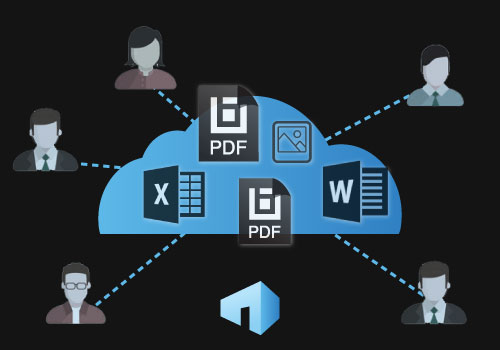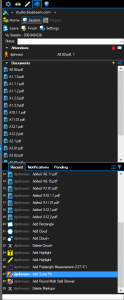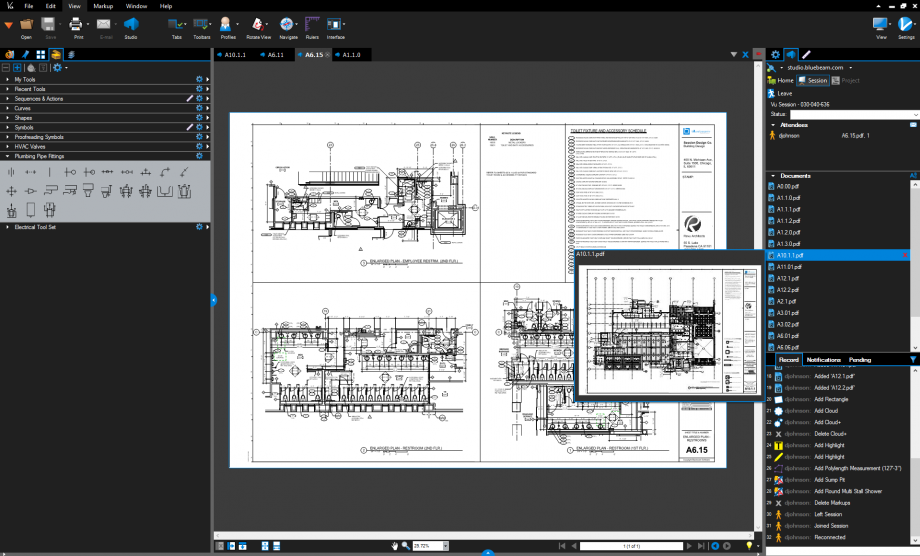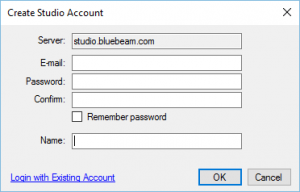Using Bluebeam Vu to access Bluebeam Studio
Applies to:
- Revu 2017 and older
 You can use Vu, Bluebeam's free PDF viewer, to view and print PDF documents, fill out and save PDF forms, and best of all, collaborate with colleagues and team members on documents in real time using our cloud-based collaboration solution, Bluebeam Studio. There are two sides to Studio: Studio Sessions and Studio Projects . This article will help you figure out which of these is best for the collaboration needs of your team, and how you can participate in either one as a Vu user.
You can use Vu, Bluebeam's free PDF viewer, to view and print PDF documents, fill out and save PDF forms, and best of all, collaborate with colleagues and team members on documents in real time using our cloud-based collaboration solution, Bluebeam Studio. There are two sides to Studio: Studio Sessions and Studio Projects . This article will help you figure out which of these is best for the collaboration needs of your team, and how you can participate in either one as a Vu user.
Studio Sessions 
Studio Sessions are for PDF-based online collaboration in real time. Using Vu to access Sessions unlocks many of the markup and tool set features normally reserved for licensed Revu users. You can take measurements to verify dimensions, add comments, Callouts ![]() , and symbols, as well as many other markups to a PDF, allowing you to communicate your thoughts, ideas or concerns to others participating in the Studio Session with you.
, and symbols, as well as many other markups to a PDF, allowing you to communicate your thoughts, ideas or concerns to others participating in the Studio Session with you.
How Does a Studio Session Work?
Studio Sessions don't require you to check files in and out. Just click on a PDF to open it, even if other users have the PDF opened. That's the appeal of Studio Sessions: real-time collaboration. All users in the Session markup the document, and everyone can see what others are adding or have added. There is also a Record (pictured to the right) that captures anything users have added, modified or removed from the PDF.
Can Other Attendees Modify My Markups?
A user’s markups are fully protected by a unique Studio login, so only the user who added a markup can edit or remove their own markup.
What If I Lose Internet Connectivity?
Vu saves a local copy of the file you're working on, so if you do lose connectivity, you can continue working and your markups will be uploaded once the connection is restored.
What if My Colleagues Aren't Available When I Am?
A Session attendee can add markups, and other team members can log in at their convenience to review what's been added. This allows you to collaborate even when schedules conflict.
More Studio Session Functions in Vu
 Bluebeam Vu logged into a Studio Session
Bluebeam Vu logged into a Studio SessionStudio ![]() Tab Use this tab to log in to Studio, open PDFs, see a Record of all user interaction with PDFs, and chat with others participating in the Session with you. There is an Attendees list so you can see who else is logged in with you.
Tab Use this tab to log in to Studio, open PDFs, see a Record of all user interaction with PDFs, and chat with others participating in the Session with you. There is an Attendees list so you can see who else is logged in with you.
Tool Chest 
The Tool Chest lets you access several predefined tool sets containing types of markups: Electrical, Mechanical, HVAC, Fire and Safety, Estimation, Proofreading and Punch Symbols, just to name a few.
Markup  Tools
Tools
 The Markup group lets you access various markup tools, like text boxes, callouts, clouds, stamps. These tools can be used for doing everything from adding comments to stamping Seals of Approval to any document. To learn more about markup tools, watch this video .
The Markup group lets you access various markup tools, like text boxes, callouts, clouds, stamps. These tools can be used for doing everything from adding comments to stamping Seals of Approval to any document. To learn more about markup tools, watch this video .
Measurement  Tools
Tools
 Go to the Measure group to calibrate your drawings and take Length
Go to the Measure group to calibrate your drawings and take Length ![]() , Area
, Area ![]() , Perimeter
, Perimeter ![]() , Diameter
, Diameter ![]() , Radius
, Radius ![]() and Angle
and Angle ![]() measurements in several different units, from inches (in) to kilometers (km) and everything in between. To learn more about taking measurements, watch this video .
measurements in several different units, from inches (in) to kilometers (km) and everything in between. To learn more about taking measurements, watch this video .
Studio Projects 
Studio Projects is Bluebeam’s simple document management system that lets registered Bluebeam Revu users store various file types in the cloud — including PDFs, Microsoft Office files and images. However, while using Vu to access a Studio Project, you'll only be able to view the PDF files – markups are restricted. If there's a PDF that you need to markup, you can ask the Project host or owner to add the PDF document to a Studio Session.
Can I Work With Other File Types in Studio Projects?
 Yes. Studio Projects supports other file types such as Excel spreadsheets and Word documents, which you can check out, edit locally, and then check in to the Project.To work with non-PDF file types (using the example of a Microsoft Excel or Word document):
Yes. Studio Projects supports other file types such as Excel spreadsheets and Word documents, which you can check out, edit locally, and then check in to the Project.To work with non-PDF file types (using the example of a Microsoft Excel or Word document):
- Right-click on the file and select Check Out. The file will now be listed in the Pending Changes section of the Project with a red check mark next to it.
- Right-click on the file again and select Open. This opens the file in the original Microsoft Office application.
- Edit the document and save your changes as you normally would in Office.
- Go back into the Studio Project and right-click on the file listed in the Pending Changes list.
- Select Check In from the menu. During the check-in process, you'll be prompted to add comments which are added to the document's Revision History.
What if I lose Internet connectivity while the document is checked out?
As long as the document was checked out and listed in the Pending Changes list, you can finish your work offline and check it in once the connection is restored.
What Else Can I Do in a Studio Project?
As a Vu user, you can perform a few other tasks while in a Studio Project. In addition to viewing files in a Project, you can print them to a physical printer, or download them to your computer and view them offline. A couple of Revu features are available too:
Measurements 
 You can use the tools in the Measurements
You can use the tools in the Measurements ![]() tab to take measurements for a quick look at dimensions. These include Length
tab to take measurements for a quick look at dimensions. These include Length ![]() , Area
, Area ![]() , Perimeter
, Perimeter ![]() , Diameter
, Diameter ![]() , Angle
, Angle ![]() , Radius
, Radius ![]() , Count
, Count ![]() , and Polylength
, and Polylength ![]() . However, since PDF editing isn't supported in Studio Projects, these dimensions won't be saved.
. However, since PDF editing isn't supported in Studio Projects, these dimensions won't be saved.
PDF Forms
Vu is great for both filling and signing PDF forms as well.
How Do I Create a Studio Account With Vu?
Alright, you should feel pretty comfortable with the differences between Studio Sessions and Studio Projects, as well as what can be done while using Vu to access Bluebeam Studio.Now that you're ready to participate in Studio, let’s get you set up with a free Studio Account.
- Open Vu and go to the Studio
 tab, or use the keyboard shortcut Alt+C.
tab, or use the keyboard shortcut Alt+C.
- Click Connect
 . This opens the Login dialog.
. This opens the Login dialog. - Click Create Account.
- When the Create Studio Account dialog appears, enter the following information:
- The email address you want to use as your Bluebeam Studio username.
This is the email address where you'll receive all Studio Session and Project invitations, as well as other emails from Bluebeam Studio such as Notifications and Alerts.
- Enter and confirm the password you want to use for your account.

- Click the Remember Password checkbox if you want Revu to log in to Studio whenever you open the program.
Only click the Use Windows Authentication checkbox if your company uses Bluebeam Studio Enterprise Server, as this won't work with studio.bluebeam.com. If you're unsure about this, please ask your IT department to confirm whether or not you need to use this authentication method.
- Click OK.
Your password needs to be between 8 and 32 characters long, with at least one uppercase letter, one lowercase letter, one number and one special character, such as !@#$%^&*."
- The email address you want to use as your Bluebeam Studio username.
- You'll receive a "Welcome to Bluebeam Studio" email containing a link for validating your new account. The account will be disabled if it isn't validated within 7 days.
If the email doesn't arrive in your inbox, please check your spam or junk email folder, and make sure that do-not-reply@bluebeamops.com is on the approved list of senders.
If you run into any difficulties with your Studio account, please contact Bluebeam Support for further assistance.
How Will I know that I'm Logged In to Bluebeam Studio?
When you're logged in, the Work Offline/Online  icon will be connected with a green light. It will appear as two disconnected cables with a red light
icon will be connected with a green light. It will appear as two disconnected cables with a red light  when you're offline.
when you're offline.
Joining a Studio Project or Session
- Open Vu and go to the Studio
 tab, or use the keyboard shortcutAlt+C.
tab, or use the keyboard shortcutAlt+C. - Click Join
 and enter the 9-digit Studio ID number when prompted.
You can find the Session or Project ID number in the email invitation you may have received from the host, or you can ask them for it. If someone has sent you a Studio Invitation and the email doesn’t appear in your inbox, please check your spam or junk email folder, and contact your IT Department to confirm that do-not-reply@bluebeamops.com is on the approved list of senders
and enter the 9-digit Studio ID number when prompted.
You can find the Session or Project ID number in the email invitation you may have received from the host, or you can ask them for it. If someone has sent you a Studio Invitation and the email doesn’t appear in your inbox, please check your spam or junk email folder, and contact your IT Department to confirm that do-not-reply@bluebeamops.com is on the approved list of senders - Click OK.
How-To
Revu 2017 & Below
Studio